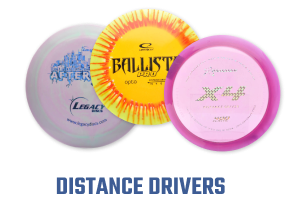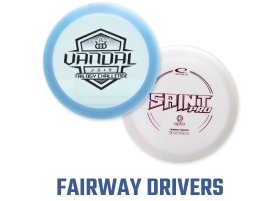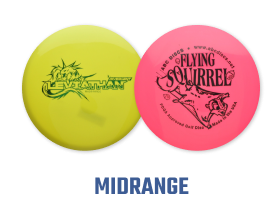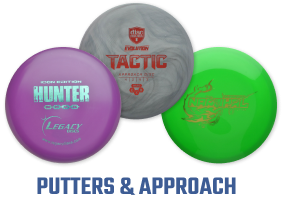
Turn, the third number in the traditional disc flight rating shown on the Innova Roadrunner (9/5/-4/1) above, is probably the most important rating for a beginner to understand about golf discs. Turn is measured on a scale from 1 (least) to (-5) most, which sounds a little strange since 1 is a bigger number than -5.
What Is Turn?
Turn is actually a measure of a disc’s resistance to horizontal motion in the direction of rotation. Turn is what the disc wants to do in the early part of flight:

Direction of turn
A disc will try to turn, or move horizontally, in the same direction that it is spinning.
RHBH (right-hand-back-hand) and LHFH (left-hand-fore-hand) throws will produce clockwise disc rotation and will cause a turn in the right-hand direction. LHBH (left-hand-back-hand) and RHFH (right-hand-fore-hand) throws will produce counter-clockwise disc rotation that will cause a turn in the left-hand direction. These two ideas are illustrated below:
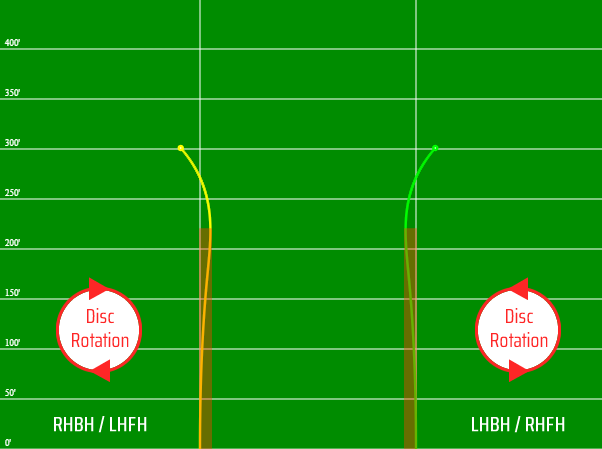
These are important things to remember for the beginner trying to figure out what their disc is supposed to do. Later in the post, I will discuss what to do if your disc isn’t turning the way it’s supposed to.
Resistance to Horizontal Motion
When you think about Turn in terms of resistance to horizontal motion, then the rating numbers make sense. A disc with a -5 turn, like the Innova Mamba (11/6/-5/1) has less resistance to turning than the Innova Wraith (11/5/-1/3) because -5 is less than -1:
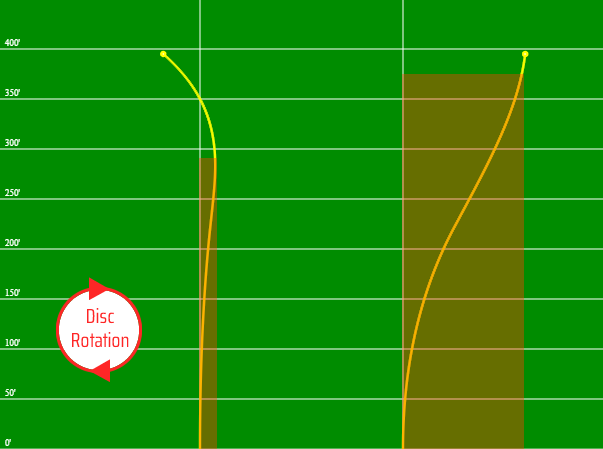
Despite both being Speed 11 discs and applying the same amount of throwing power to each, you can see that the Wraith with a -1 Turn resists turning much more effectively than the Mamba with a -5 Turn.
Disc Stability
You will often hear the terms Stable, Understable, and Overstable discs. These three terms relate most to the amount of turn a disc has.
Stable discs tend to fly straight and do not deflect much from the direction of launch during either the Turn or Fade portions of flight. Typically you won’t see a Stable disc with a Turn less than -1. Some popular examples of Stable discs are the Discraft Buzzz (5/4/-1/1) and the Innova TL3 (8/4/-1/1).
Understable discs tend to move a lot horizontally during the early part of flight and may or may not return back to the line of the initial launch. The Latitude 64 Diamond (8/6/-3/1) and the Innova Sidewinder (9/5/-3/1) are examples of Understable discs.
Overstable discs tend to fly mostly straight at the beginning, and then finish strong in the direction opposite disc rotation. The Dynamic Discs Defender (13/5/0/3) and the Discraft Buzzz OS (5/4/0/3) are both Overstable discs.
Here are examples of each different type of flight path:

Why Do I Want Turn?
You might be asking yourself why you would want a disc that turns? Why not just throw something that will go straight? Without going into too much detail (that’s for other articles), there are several reasons why you would want a disc that turns:
- The best way to maximize distance is to throw a nice long “S” curve. Straight flying discs won’t do this without excess power or an anhyzer release (releasing the disc on an angle rather than flat). A disc with a Turn rating less than 0 will want to produce some amount of “S” curve in its flight, which will keep it aloft longer and allow for more distance.
- The only way to produce a “hyzer flip” is by throwing a disc that will turn, causing it to “flip-up” right after release. A hyzer flip shot can fly straight and produce the same distance as an “S” curve without requiring the same left-to-right room as a flat shot that turns a lot before coming back. Hyzer flips are good for tunnel shots that require distance and for players that naturally throw with a hyzer angle.
- Roller shots – where the disc spends more time rolling towards the target than flying – are best achieved with a very understable disc; that is one with a Turn rating of -3 or less.
- Discs with lots of Turn can help players with slower arm speeds offset their lack of power and keep the disc going straight longer before starting to Fade out.
- With a lot of tailwind, choose a disc with more Turn because the tailwind will have the same impact as reducing your throwing speed.
- If you are throwing in the woods you might not have a direct line to the basket or landing zone, and the only way to navigate through the trees is to create an “S” curve that can literally weave through the gaps.
Any Disc Will Turn
With enough power, any disc can and will turn. The discs with the most resistance to turning (Turn: 0 or 1) require an almost super-human amount of power to make them turn.
Below are two flight paths for the Innova Roc3 (5/4/0/3):

The Roc3 has a Turn of 0, which means that at normal power levels you would not expect any horizontal turn during the early part of flight. This is shown in the flight path on the left.
However, if you apply a professional level of power to the disc – as in the flight path on the right – you will get disc flight that does indeed turn to the right (RHBH/LHFH).
The fastest recorded thrown disc is approximately 90 mph by Simon Lizotte (doing his best Michael Cera impersonation). That level of power might be sufficient to make a Speed 13 or 14 disc with Turn 0 move a little during flight, but there are only a handful of humans on the planet that can do it.
My Disc Isn’t Turning
If you find that you’re throwing a disc and it doesn’t appear to be flying the way the Turn rating says it should do not despair. This is common for beginners or those with slower arm speeds.
The two most common reasons for this are using a disc that is too fast for your arm speed and bad throwing mechanics.
As covered in my post about Disc Speed Ratings, experimentation can help you determine the Speed of discs you should be throwing to produce the Turn that the disc is rated for. If you haven’t already, check out that post to see tips on how to find discs for your arm speed.
If your throwing mechanics are still a work in progress (meaning you’re throwing the disc way up in the air, or with the nose of the disc pointed up), then the discs will not fly as designed. There will be future posts about fixing faulty mechanics, but that is far too broad a topic for this post. If you suspect your mechanics are poor, I recommend that you don’t worry too much about the numbers on your disc, and focus on throwing the disc flat with as much power as you can muster while maintaining control. Only then should you start to worry about flight ratings.
That’s Turn in a Nutshell
Hopefully, this post has been helpful in understanding what turn is and what you should expect from your discs. If you’re a righty throwing a Discraft Archer (5/4/-4/1) and getting frustrated that it’s going right when you wanted it to go left, maybe now you know why.

